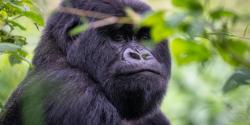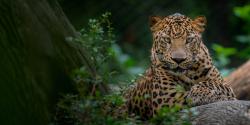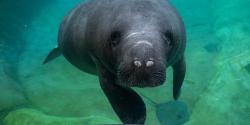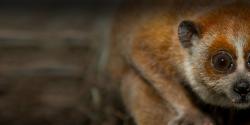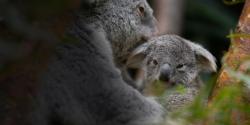Featured Species
Barbary lion (Panthera leo leo)
The story of the extinction of the barbary lion shows us that even when sightings of a species seem to have ended, conservation efforts should continue. The barbary lion was elieved to have been extinct by 1925, but a female lioness was encountered in 1942.
Extinct due to:
- Exploitation (kept by individuals)
- Romans killed thousands in the Coliseum gladiator spectacles
- Fragmented population was finished off by European hunters in the 19th century
Habitat & Range: Once roamed throughout the deserts and mountains of northern Africa, ranging from Morocco to Egypt, far to the north of their sub-Saharan relatives.
Hill’s horseshoe bat (Rhinolophus hillorum)
These bats use echolocation to detect insects, which they then eat while in flight.
Conservation Status: Vulnerable, populations are decreasing
Habitat & Range: Endemic to the major highland areas of the Upper (Guinea and Liberia) and Lower (Nigeria and Cameroon) Guinean Forest of West Africa
Threats
- Forest fragmentation and habitat degradation due to wildfires, farming, logging, and human development
- Severe weather caused by climate change
Grevy’s zebra (Equus grevyi)
Conservation efforts, such as, population monitoring, and education and involvement of local communities have helped to keep populations of Grevy’s zebra stable from 2008 to 2016, when the population was last assessed.
Conservation Status: Endangered, populations are stable
Habitat & Range: live in arid and semi-arid grass/shrubland where they can gain access to permanent water; only found in the Horn of Africa, specifically Ethiopia and Kenya
Threats
- Habitat degradation and loss
- Drought
- Competition for limited resources with livestock
- Poaching
Lesser flamingo (Phoeniconaias minor)
Lesser flamingos are social animals that are most active at dusk and dawn when they feed.
Conservation Status: Near Threatened, populations are decreasing. Conservation efforts are focused on their breeding grounds at Lake Nakuru, in hopes of stabilizing and even increasing their population.
Habitat & Range: breeds in large undisturbed alkaline and saline lakes, salt pans, or coastal lagoons (usually far out from the shore) in Ethiopia, Kenya, and Tanzania. Three smaller breeding congregations occur in West Africa, in southern Africa, and in India and Pakistan. When not breeding, it occurs in nearly every sub-Saharan country and from the Arabian Peninsula to Pakistan.
Threats
- Breeding site destruction due to deforestation, farming, drainage, pollution, and industry
- Land-claim, water pollution, and collisions with electric wires
Black rhino (Diceros bicornis)
These large herbivores use their horns to gain access to more food by breaking off branches or knocking down plants.
Conservation Status: Critically Endangered, populations are increasing
Habitat & Range: occur in a wide variety of habitats from desert areas to wooded areas in southern Africa
Threats
- Poaching to supply the illegal rhino horn trade (Chinese medicine and ornamental use)
- Habitat and population fragmentation
White rhino (Ceratotherium simum)
These beneficial herbivores help reduce the chance for wildfires with their grazing.
Conservation Status: Near Threatened, populations are decreasing
Habitat & Range: found in grassland in savanna habitats in central and south Africa
Threats
- Poaching to supply the illegal rhino horn trade (Chinese medicine and ornamental use)
- Civil wars causing habitat and population fragmentation
Panther chameleon (Furcifer pardalis)
These vibrant colored lizards have some fascinating adaptations, such as their eyes that can rotate and focus separately, allowing them to focus on two different items at the same time.
Conservation Status: Least Concern, populations are stable
Habitat & Range: Endemic to Madagascar where it is widespread in lowland scrub and forest habitat of the northeast and east
Threats: Although this is the most sought-after Malagasy chameleon in the international pet trade, current levels of exploitation are not thought to represent a threat.
Chimpanzee (Pan troglodytes)
These social primates travel on the ground, but rest and eat in trees. Their larger community can split into smaller groups that vary and change regularly.
Conservation Status: Endangered, populations are decreasing
Habitat & Range: Chimpanzees have by far the widest geographic distribution of any great ape, with a range of over 1.6 million square miles. They have a fragmented distribution from southern Senegal across the forested belt north of the Congo River to western Tanzania and western Uganda. Found in a range of forest habitats and segmented forested areas near farmlands.
Threats
- Even though all killing, capture or consumption of great apes is illegal, poaching is the greatest threat to most Chimpanzees.
- Habitat loss and degradation (slash-and-burn agriculture, industrial agriculture, logging, mining, and oil)
- Disease from humans as their habitats continue to overlap
Reticulated giraffe (Giraffa camelopardalis ssp. reticulata)
A giraffe’s height provides them with the opportunity to spot predators from a distance and stay in visual contact with their herd.
Conservation Status: Endangered, populations are decreasing
Habitat & Range: most often found in savanna/woodland habitats in north-eastern Kenya, and across the borders in south-eastern Ethiopia and south-western Somalia
Threats
- Habitat loss and fragmentation
- Poaching
- Habitat degradation and loss, drought
- Competition for limited resources with livestock
African Leopard (Panthera pardus pardus)
A leopard's pattern varies geographically possibly due to their assorted habitats. As ambush predators, their camouflage helps them surprise their prey and hide from their own predators.
Conservation Status: Vulnerable, populations are decreasing
Habitat & Range: The African subspecies is found in a wide range of habitats, including desert and semi-desert regions of southern Africa in Namibia and Botswana, rainforests of West and Central Africa, and suburban/urban environments in parts of sub-Saharan Africa
Threats
- Habitat fragmentation
- Reduced prey animals and conflict with livestock and game farming
- Poaching and illegal trade
Addax (Addax nasomaculatus)
These antelopes search great distances throughout the Sahara Desert for grasses to eat.
Conservation Status: Critically Endangered, populations are decreasing. They're listed as Critically Endangered because the total population is estimated to be under 100.
Habitat & Range: The only known remaining population thought to be viable is in Niger, although there are sporadic records of small groups or individuals in other areas.
Threats
- Uncontrolled hunting over many years, especially in the 20th century due to increased efficiency in hunting technology
- Drought and competition with livestock
- Disturbance by oil exploration and production
- Political instability in the area and violence


